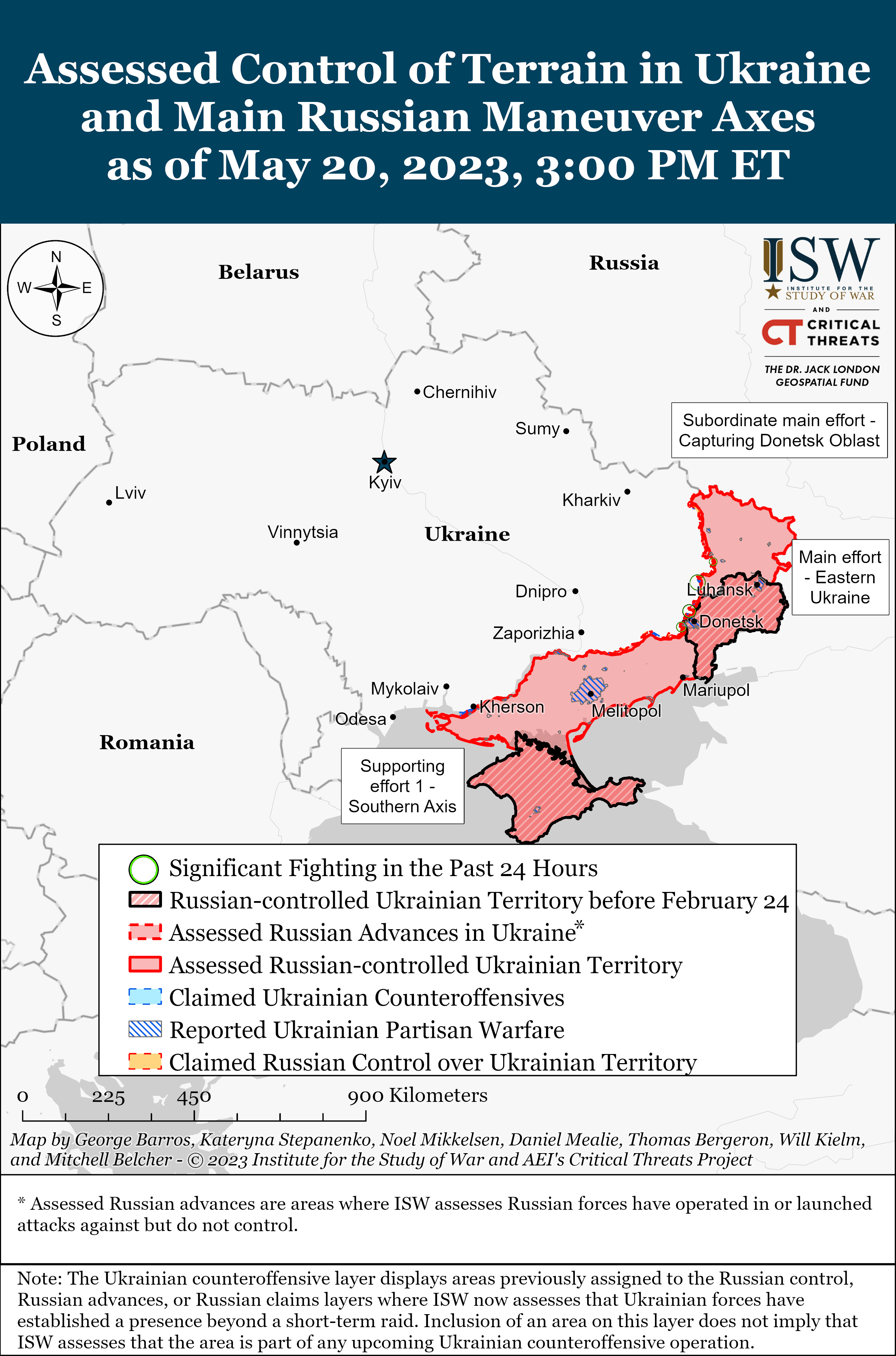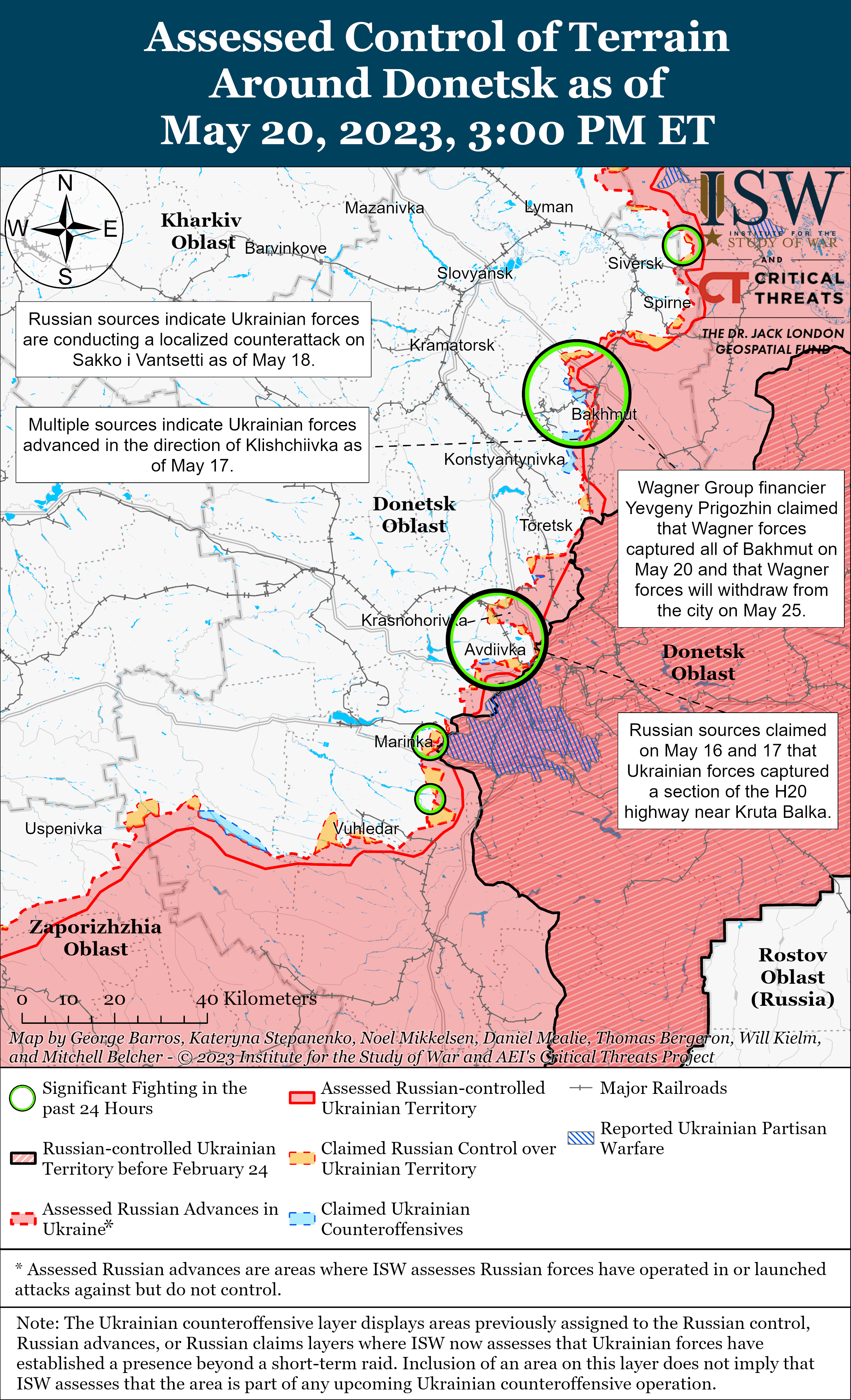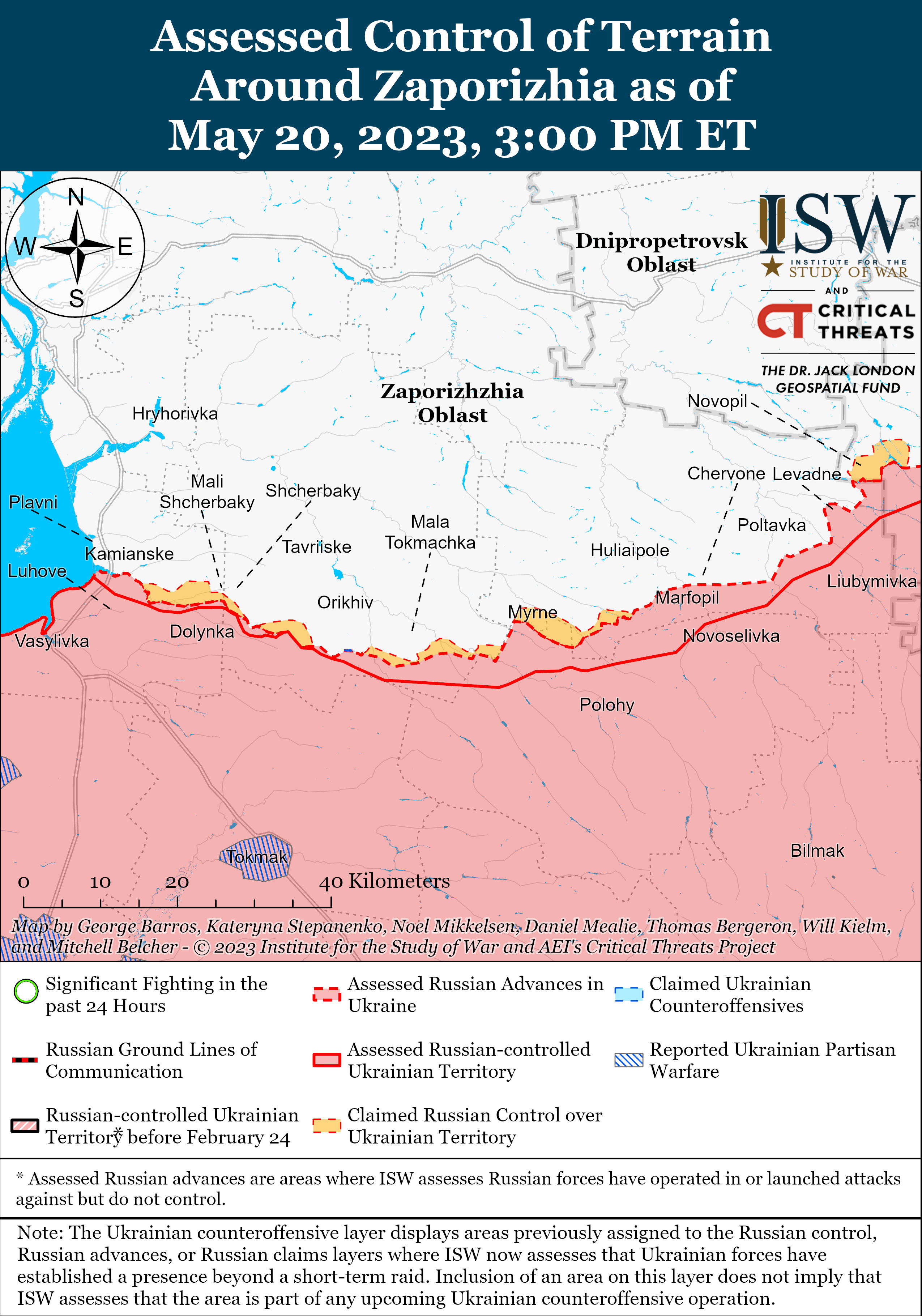Russian Offensive Campaign Assessment, May 20, 2023
AFGHANISTAN, May 20 - Russian Offensive Campaign Assessment, May 20, 2023
Kateryna Stepanenko, Riley Bailey, Grace Mappes, George Barros, and Frederick W. Kagan
May 20, 2023, 5:45pm ET
Click here to see ISW’s interactive map of the Russian invasion of Ukraine. This map is updated daily alongside the static maps present in this report.
Click here to access ISW’s archive of interactive time-lapse maps of the Russian invasion of Ukraine. These maps complement the static control-of-terrain map that ISW produces daily by showing a dynamic frontline. ISW will update this time-lapse map archive monthly.
Note: The data cutoff for this product was 12pm ET on May 20. ISW will cover subsequent reports in the May 21 Russian Offensive Campaign Assessment.
Wagner Group financier Yevgeny Prigozhin declared victory in Bakhmut City on May 20 and announced his intent to withdraw from the city on May 25.[1] Prigozhin claimed that Wagner Group forces completely captured Bakhmut City on May 20, seizing the last multi-story apartment building in southwestern Bakhmut near the MiG-17 monument. Prigozhin announced that Wagner forces will establish defensive positions before transferring responsibility for the city to Russian conventional forces on May 25. Prigozhin effectively stated that Wagner forces will conduct an operational pause by resting and restoring combat power at field training camps in unspecified areas, presumably far from the frontline. ISW has not observed geolocated footage confirming Prigozhin’s claims as of this publication. Ukrainian officials reported that Ukrainian forces are still fighting in a small section of southwest Bakhmut as of May 20. Ukrainian Deputy Defense Minister Hanna Malyar stated that Ukrainian forces continue to hold positions near the MiG-17 monument as of May 20.[2] The Russian Ministry of Defense (MoD) has not commented on Prigozhin’s claims as of this publication.
Prigozhin’s claimed victory over the remaining areas in Bakhmut is purely symbolic even if true. The last few urban blocks of eastern Bakhmut that Prigozhin claimed that Wagner Group forces captured are not tactically or operationally significant. Their capture does not grant Russian forces operationally significant terrain to continue conducting offensive operations or any particularly strong position from which to defend against possible Ukrainian counterattacks.
Ukrainian forces continue pressuring Bakhmut’s northern and southern flanks. Ukrainian and Russian sources reported that fighting is ongoing on Bakhmut’s northern and southern flanks in the directions of Ivanivske (6km west of Bakhmut), Stupochky (13km southwest of Bakhmut), and Bila Hora (12km southwest of Bakhmut).[3] Ukrainian forces reported on May 19 that they have recaptured approximately four square kilometers of additional territory near Bakhmut, and Russian sources claimed that Ukrainian forces continue conducting localized attacks near Klishchiivka (6km southwest of Bakhmut).[4] Prigozhin’s claimed capture of the remaining blocks in Bakhmut is not strategically significant as it will not allow exhausted Wagner or conventional Russian forces to establish a meaningful springboard for further offensive operations. Ukrainian ongoing counterattacks north, west, and southwest of Bakhmut will complicate any further Russian advances beyond Bakhmut in the near term. Prigozhin’s withdrawal announcement, whether Wagner withdraws from the city or not, indicates that Prigozhin does not intend to continue an offensive effort to push directly west of Bakhmut.
Wagner forces are unlikely to successfully conduct a controlled withdrawal from Bakhmut while in contact with Ukrainian forces within five days without disrupting the Russian MoD’s efforts to prepare for planned Ukrainian counteroffensives. Wagner forces are unlikely to establish adequate defenses or consolidate recent gains in Bakhmut sufficient to forestall Ukrainian counterattacks by May 25 even if Prigozhin’s announcement of Wagner’s withdrawal is true. Ukrainian forces are still in Khromove and Ivanivske and are engaging Russian forces in and near Bakhmut. Ukrainian artillery can still target Russian forces in and around Bakhmut. Withdrawal in contact with the enemy is an exceedingly difficult task that the Wagner Group’s forces are unlikely to perform well within Prigozhin’s five-day time frame. Conducting a relief-in-place while in contact is also an extremely challenging maneuver that Russian forces would likely struggle to conduct even if the Russian MoD agrees to undertake it. Wagner units have shown poor coordination with Russian conventional forces, other irregular formations subordinated to the Russian MoD, and the Russian military command—factors that would hinder a smooth relief-in-place operation.[5] The Russian military command is unlikely to generate sufficient forces to relieve Wagner in Bakhmut and hold its flanks within the window Prigozhin has announced without redeploying Russian forces from other areas. Prigozhin’s statement of his intent to withdraw could be a crude attempt to mislead Ukrainian forces into conducting a counterattack through Bakhmut City.
Russian conventional forces likely will still need to transfer additional forces to the Bakhmut direction even if Wagner mercenaries remain in Bakhmut. Ukrainian Eastern Group of Forces Spokesperson Colonel Serhiy Cherevaty stated that Russian forces continue to transfer airborne, motorized rifle, and special forces elements to reinforce the Bakhmut flanks even as Wagner forces remain in Bakhmut City.[6] The UK MoD also reported that the Russian military command likely redeployed several battalions in the last few days to reinforce Bakhmut despite only having few uncommitted combat units and that this redeployment suggests a substantial commitment to the Bakhmut effort by the Russian leadership.[7] These additional forces could in principle be meant to participate in the relief-in-place of Wagner forces that Prigozhin has just announced, reducing but not eliminating some of the challenges considered above, but it is more likely that they are intended to secure Bakhmut’s threatened flanks.
Russian forces targeted Kyiv Oblast with Iranian-made Shahed drones on the night of May 19 to 20. The Ukrainian General Staff reported that Russian forces launched 18 Shahed-136/131 drones at Kyiv Oblast, and that Ukrainian air defenses shot down all 18 of the drones.[8] The Ukrainian General Staff also reported that Ukrainian forces destroyed two Russian Shahed drones in eastern Ukraine.[9] Russian forces have targeted Kyiv heavily in the past month, likely to produce informational affects with both Russian and Ukrainian audiences. This hyperfocus on targeting Kyiv is at odds with the new limited Russian air campaign’s other target: alleged Ukrainian rear logistics.[10] These conflicting target sets likely further limit the campaign’s ability to degrade Ukrainian counteroffensive capabilities in the near term.[11]
US National Security Advisor Jake Sullivan stated on May 20 that the United States may agree to transfer modern combat aircraft to Ukraine, including the F-16, on the condition that Ukraine does not use them to strike Russian territory. Sullivan stated the war in Ukraine has “evolved” and that F-16 fourth-generation fighter aircraft have now become “part of that mix” of weapons that Ukraine will need as part of a “future force to be able to deter and defend against Russian aggression as we go forward.”[12] Sullivan stated that any F-16s given to Ukraine – like other Western weapons provided to Ukraine – will be provided under the condition that they do not strike Russian territory.[13] Sullivan also stated that training Ukrainian pilots to use F-16s is the “obvious first step” and that the next steps are to “determine how to do the actual provision of planes.”[14] US President Joe Biden informed G7 leaders on May 19 that Washington will support a joint effort to train Ukrainian pilots on F-16s and other fourth generation aircraft but did not pledge that the US will send Ukraine the F-16s.[15]
Ukrainian Deputy Defense Minister Hanna Malyar reported that Russian sources are falsely alleging that high-ranking Ukrainian military commanders have recently died, likely to demoralize the Ukrainian forces and to portray Russian forces as constraining Ukrainian counteroffensive capabilities. Malyar stated that these information operations allege that Russian strikes have recently killed Ukrainian Territorial Defense Forces Commander General Ihor Tantsyura, Ukrainian Eastern Grouping of Forces Commander Colonel General Oleksandr Syrskyi, and Ukrainian Commander in Chief General Valeriy Zaluzhnyi.[16] Prigozhin also amplified the information operation alleging that Zaluzhnyi might be dead on May 20.[17] These information operations are particularly absurd given that Zaluzhnyi spoke with US Chairman of the Joint Chiefs of Staff General Mark Milley on May 19 and that Syrskyi appeared on Ukrainian television on May 16.[18] Ukrainian officials have denied previous Russian claims that a May 10 strike on a Ukrainian command post in the Bakhmut area killed several high-ranking Ukrainian military officials and that Wagner forces killed Tantsyura while he was en route to Bakhmut on May 2.[19] ISW has previously assessed that Russian ultranationalists are increasingly seeking to frame any Russian operations as delaying potential Ukrainian counteroffensive actions.[20]
Key Takeaways
- Wagner Group financier Yevgeny Prigozhin declared victory in Bakhmut City on May 20 and announced his intent to withdraw from the city on May 25.
- Prigozhin’s claimed victory over the remaining areas in Bakhmut is purely symbolic even if true.
- Ukrainian forces continue pressuring Bakhmut’s northern and southern flanks.
- Wagner forces are unlikely to successfully conduct a controlled withdrawal from Bakhmut while in contact with Ukrainian forces within five days without disrupting the Russian MoD’s efforts to prepare for planned Ukrainian counteroffensives.
- Russian conventional forces likely will still need to transfer additional forces to the Bakhmut direction even if Wagner mercenaries remain in Bakhmut.
- Russian forces targeted Kyiv Oblast with Iranian-made Shahed drones on the night of May 19 to 20.
- US National Security Advisor Jake Sullivan stated on May 20 that the United States may agree to transfer modern combat aircraft to Ukraine, including the F-16, on the condition that Ukraine does not use them to strike Russian territory.
- Ukrainian Deputy Defense Minister Hanna Malyar reported that Russian sources are falsely alleging that high-ranking Ukrainian military commanders have recently died, likely to demoralize Ukrainian forces and to portray Russian forces as constraining Ukrainian counteroffensive capabilities.
- Russian forces continued limited ground attacks in the Kreminna area.
- Russian forces continued to conduct ground attacks on the Avdiivka-Donetsk City line.
- The Washington Post reported on May 19 that a Ukrainian commander stated that Ukrainian Special Operations forces conduct raids in east (left) bank Kherson Oblast but that Ukrainian forces do not hold stable positions there.
- The Russian Ministry of Defense (MoD) is incorporating mobilized and conscripted personnel into its own “Veterany” private military company (PMC), leading to discrimination and conflict.
- A Lithuanian official publicly accused Russia of attempting to hold international children hostage in occupied Crimea as “human shields” against a future Ukrainian counteroffensive.
We do not report in detail on Russian war crimes because these activities are well-covered in Western media and do not directly affect the military operations we are assessing and forecasting. We will continue to evaluate and report on the effects of these criminal activities on the Ukrainian military and the Ukrainian population and specifically on combat in Ukrainian urban areas. We utterly condemn these Russian violations of the laws of armed conflict, Geneva Conventions, and humanity even though we do not describe them in these reports.
- Russian Main Effort – Eastern Ukraine (comprised of two subordinate main efforts)
- Russian Subordinate Main Effort #1 – Capture the remainder of Luhansk Oblast and push westward into eastern Kharkiv Oblast and encircle northern Donetsk Oblast
- Russian Subordinate Main Effort #2 – Capture the entirety of Donetsk Oblast
- Russian Supporting Effort – Southern Axis
- Russian Mobilization and Force Generation Efforts
- Activities in Russian-occupied areas
Russian Main Effort – Eastern Ukraine
Russian Subordinate Main Effort #1 – Luhansk Oblast (Russian objective: Capture the remainder of Luhansk Oblast and push westward into eastern Kharkiv Oblast and northern Donetsk Oblast)
Russian forces continued limited ground attacks in the Kreminna area on May 20. The Ukrainian General Staff reported that Russian forces conducted unsuccessful offensive operations near Bilohorivka, Luhansk Oblast (12km south of Kreminna).[21] A Russian miblogger claimed that Russian forces conducted assaults in the Serebrianska forest area and advanced towards Hryhorivka (11km south of Kreminna).[22] Ukrainian Eastern Group of Forces Spokesperson Colonel Serhiy Cherevaty stated on May 20 that the tempo of Russian assaults along the Kupyansk-Svatove-Kreminna line has decreased over the past month from five to seven daily assaults to one daily assault.[23]
A prominent Russian milblogger claimed that Ukrainian forces conducted unsuccessful counterattacks to regain lost positions near Masyutivka (13km northeast of Kupyansk) on May 19.[24] The milblogger also claimed that Russian forces continue to successfully hold a bridgehead on the west (right) bank of the Oskil River in the area.[25] ISW has still not observed visual confirmation of the Russian capture of Masyutivka or the establishment of a Russian bridgehead on the west bank of the Oskil River.
Russian Subordinate Main Effort #2 – Donetsk Oblast (Russian Objective: Capture the entirety of Donetsk Oblast, the claimed territory of Russia’s proxies in Donbas)
See topline text on Bakhmut.
Russian forces continued to conduct ground attacks on the Avdiivka-Donetsk City line on May 20. The Ukrainian General Staff reported that Russian forces conducted unsuccessful offensive operations near Novokalynove (8km north of Avdiivka), Stepove (2km north of Avdiivka), Avdiivka, Sieverne (5km west of Avdiivka), Pervomaiske (11km southwest of Avdiivka), and Novomykhailivka (36km southwest of Avdiivka).[26] A Russian milblogger claimed that Russian forces unsuccessfully attacked Pervomaiske and Nevelske (14km southwest of Avdiivka) but advanced to the railway north of Avdiivka from Krasnohorivka (8km north of Avdiivka).[27] Another Russian milblogger claimed that Ukrainian forces made several successful advances in the Donetsk direction in the past week but that Russian forces have stabilized the front near Krasnohorivka.[28] The General Staff also reported that Ukrainian forces repelled over 20 ground attacks in the Marinka (27km southwest of Avdiivka) area.[29] Ukrainian Deputy Defense Minister Hanna Malyar reported that Ukrainian defenses in Marinka forced Russian forces to attack on the northern and southern flanks instead.[30]
Ukrainian forces struck the Mariupol airport on the night of May 19. Geolocated footage shows four Ukrainian rounds striking the Mariupol airport area, and some sources speculated that the strikes hit a Russian military concentration point.[31] Some Russian sources speculated that Ukrainian forces used Storm Shadow missiles to target the airport area.[32] Ukrainian forces last struck Mariupol in February prior to the delivery of the Storm Shadow missiles. Some sources speculated that Ukrainian forces used Ground Launched Small Diameter Bombs (GLSDBs) in those strikes.[33] Russian milbloggers amplified geolocated imagery of smoke trails and claimed that Russian air defenses intercepted two additional rockets or missiles on the morning of May 20.[34] The milbloggers claimed that Ukraine targeted Mariupol in order to commemorate the anniversary of the Russian capture of Mariupol on May 20, 2022.
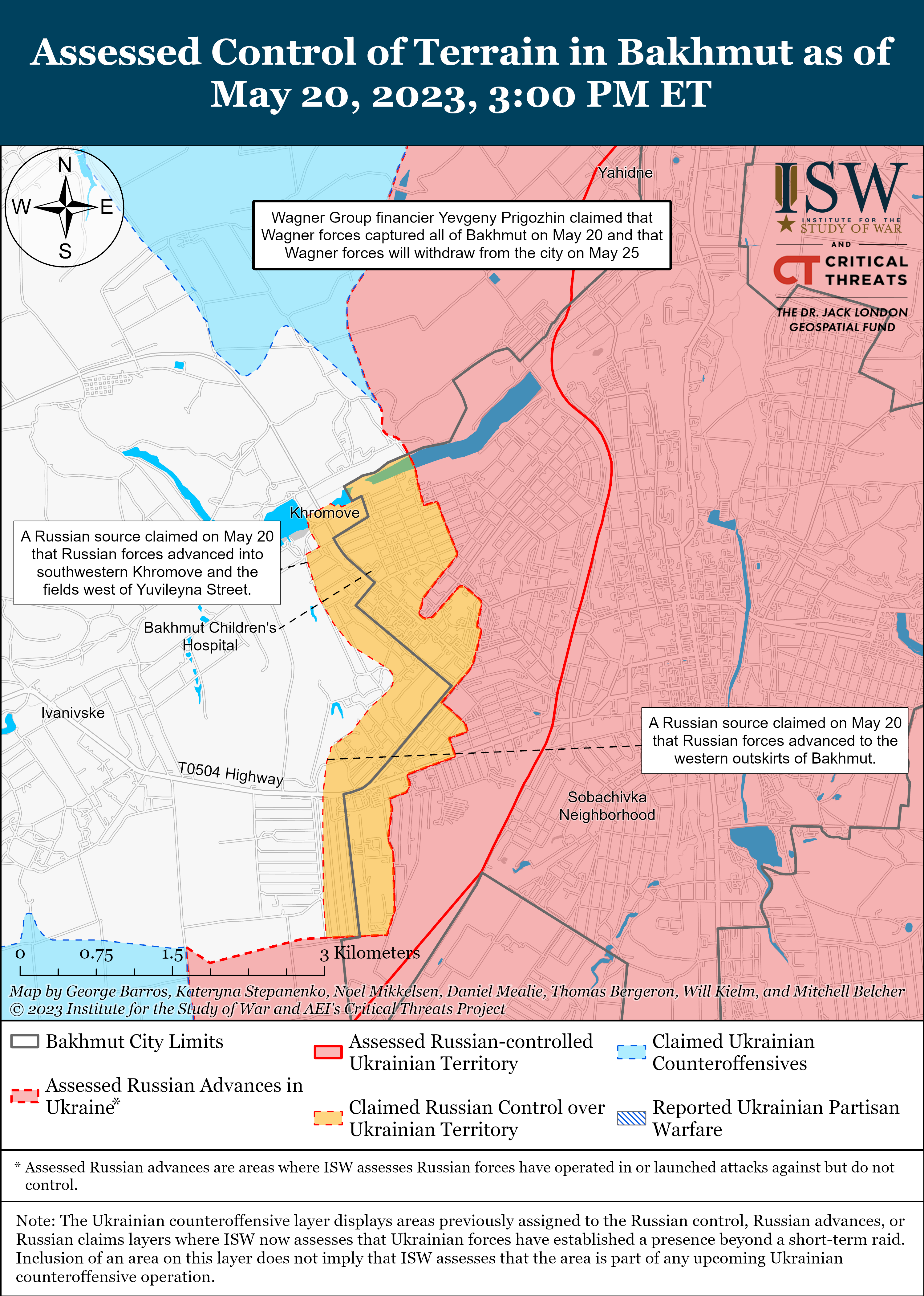
Russian Supporting Effort – Southern Axis (Russian objective: Maintain frontline positions and secure rear areas against Ukrainian strikes)
The Washington Post reported on May 19 that the Ukrainian commander of the operational group of Kherson troops, Brigadier General Mykhaylo Drapatyy, stated that Ukrainian Special Operations forces conduct raids in east (left) bank Kherson Oblast but that Ukrainian forces do not hold stable positions there.[35] Drapatyy reportedly added that Ukrainian assault units train twice a week for operations to cross the Dnipro River using boats and pontoon bridges, and The Washington Post reported that Ukrainian forces have begun constructing pontoon bridges that could be used to transport heavy weaponry across the river.[36] Drapatyy reportedly stated that Ukrainian forces may use islands in the Dnipro River delta to launch operations on the east bank and claimed that Ukrainian forces control 90 percent of the islands through physical, visual, and artillery means.[37] Drapatyy reportedly highlighted the fact that Russian forces are worried that Ukraine is preparing for active operations in the Kherson direction and that they have recently begun fortifying their defenses in the rear and planting more mines on the east bank.[38] Drapatyy's statements are generally consistent with previous Ukrainian officials' comments about the continued but limited nature of Ukrainian operations on islands in the delta and on the east bank.[39] The Washington Post reported that Russian positions on the east bank are up to 4.8km away from the Dnipro River, although ISW has not observed visual confirmation of this reporting.[40] Geolocated footage published on May 20 indicates that Ukrainian forces are operating in additional areas on Cherkesky Island (26km southwest of Kherson City).[41]
A Russian milblogger claimed on May 20 that Ukrainian forces counterattacked near Dorozhnyanka, Zaporizhia Oblast (7km south of Hulyaipole) and made unspecified marginal gains in the area.[42] ISW has not observed visual confirmation of recent Ukrainian gains in the Hulyaipole area.
The Ukrainian Resistance Center reported on May 20 that Chechen Republic Head Ramzan Kadyrov deployed additional elements of the “Yug-Akhmat” motorized rifle battalion to Zaporizhia Oblast.[43] Kadyrov has previously claimed that “Yug-Akhmat” elements are operating in Zaporizhia Oblast, possibly as internal security forces in the area.[44]
Russian sources claimed on May 20 that Russian electronic warfare units downed a Ukrainian Mugin-5 drone in northern Crimea.[45]
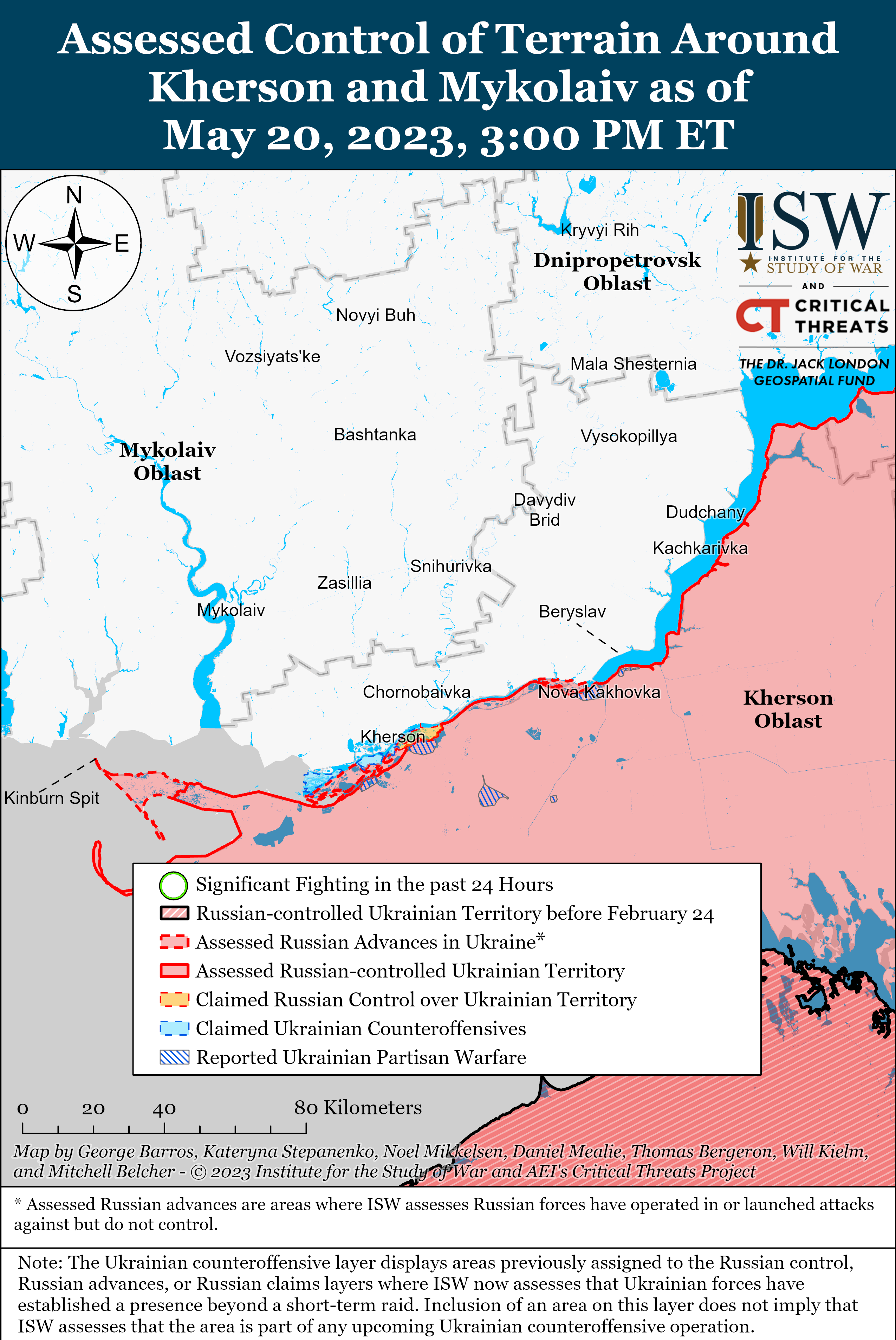
Russian Mobilization and Force Generation Efforts (Russian objective: Expand combat power without conducting general mobilization)
The Russian Ministry of Defense (MoD) is incorporating mobilized and conscripted personnel into its own “Veterany” private military company (PMC), leading to discrimination and conflict.[46] ISW previously reported that Veterany is part of Russian MoD’s Redut PMC reportedly operating on the Bakhmut flanks.[47] Wives and mothers of mobilized servicemen from Khakassia and Altai republics published a video appeal to Russian President Vladimir Putin complaining that Veterany mercenaries are not keeping track of casualties among mobilized personnel and are not supporting mobilized men on the frontlines.[48] The wives and mothers noted that only 137 of 500 deployed mobilized men returned from the frontlines and claimed that at least two units of unknown echelon subordinate to Veterany are missing. The family members also noted that Veterany mercenaries claimed to have purchased each mobilized man for 25,000 rubles (about $315) per serviceman to fight in their place. Commander of the Ukrainian Ground Forces, Colonel General Oleksandr Syrskyi stated that Ukrainian forces captured a mobilized serviceman who served in the Veterany PMC – likely in the Bakhmut direction.[49]
The Financial Times (FT) reported that Wagner Group purchased 20,000 helmets worth approximately $2 million from a small Chinese company “Hangzhou Shineraine Import and Export Co.” in November and December 2022 via Russian-based company Broker Expert.[50] Wagner Group financier Yevgeny Prigozhin denied purchasing supplies from the company. FT reported that Broker Expert has continued to ship items supporting Wagner’s operations in Africa during the full-scale invasion of Ukraine.
Activities in Russian-occupied areas (Russian objective: Consolidate administrative control of annexed areas; forcibly integrate Ukrainian civilians into Russian sociocultural, economic, military, and governance systems)
A Lithuanian official publicly accused Russia of attempting to hold international children hostage in occupied Crimea as “human shields” against a future Ukrainian counteroffensive. Lithuanian National Security and Defense Committee Chairperson Laurynas Kaciunas claimed on May 18 that Russia is trying to lure children from Kazakhstan, Israel, Belgium, Morocco, Tajikistan, Egypt, Armenia, and other unspecified countries to the “Artek” children’s camp in Crimea under various recreational, cultural, and educational schemes, including for winning competitions.[51] Kaciunas claimed that Russia also aims to compel the international community to recognize Russia’s claim to Crimea. ISW cannot verify Kaciunas’s claim, but it is consistent with efforts to draw children from occupied areas of Ukraine to Crimea under summer vacation, health, and other camp schemes.[52] Russian Human Rights Commissioner Maria Lvova-Belova attempted to portray Russia as a safe and trustworthy custodian of non-Russian children by claiming that Russia returned one Ukrainian child to her family.[53]
Significant activity in Belarus (ISW assesses that a Russian or Belarusian attack into northern Ukraine in early 2023 is extraordinarily unlikely and has thus restructured this section of the update. It will no longer include counter-indicators for such an offensive.)
ISW will continue to report daily observed Russian and Belarusian military activity in Belarus, but these are not indicators that Russian and Belarusian forces are preparing for an imminent attack on Ukraine from Belarus. ISW will revise this text and its assessment if it observes any unambiguous indicators that Russia or Belarus is preparing to attack northern Ukraine.
Nothing significant to report.
Note: ISW does not receive any classified material from any source, uses only publicly available information, and draws extensively on Russian, Ukrainian, and Western reporting and social media as well as commercially available satellite imagery and other geospatial data as the basis for these reports. References to all sources used are provided in the endnotes of each update.
Legal Disclaimer:
EIN Presswire provides this news content "as is" without warranty of any kind. We do not accept any responsibility or liability for the accuracy, content, images, videos, licenses, completeness, legality, or reliability of the information contained in this article. If you have any complaints or copyright issues related to this article, kindly contact the author above.

